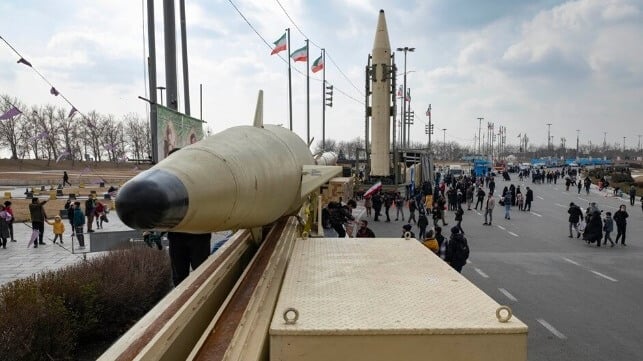Upgraded Houthi Missiles Pose a Problem for Shipping

The successful penetration of Israeli air defenses, as occurred when a Houthi missile hit an empty space within the grounds of Tel Aviv airport, would not normally merit a mention in the annals of the Maritime Executive. In this instance, however, it is emerging from the May 4 attack that the Houthis have a capability which could threaten both ports and ships at sea.
This may explain why the carrier USS Harry S. Truman (CVN-75) has been seen performing vigorous evasive maneuvers in the Red Sea, one of which is likely on April 28 to have caused the loss overboard of an F/A-18 being deck-handled.
Update: CSG 8
— MT Anderson (@MT_Anderson) April 29, 2025
The image below is from 23 April, not 28 April
Could be an issue on the Sentinel side given their delays in sharing Red Sea imagery or it was my error (more likely)
Regardless, apologies for the incorrect date and on the post https://t.co/Cz8YdGwn5e
What the Houthis described as a Palestine-2 missile impacted on waste ground within Ben Gurion International Airport, landing within 500 yards of the Terminal 3 building and injuring a number of people in the adjacent car park. Attempts to shoot down the incoming missile using both US THAAD batteries and Israel’s Arrow-2/3 systems both failed, although Israel claimed the missile type was not new, had been shot down before, and that technical faults had affected both interceptor systems.
In reality, the likelihood of simultaneous faults occurring on two separate interceptor systems is low. This apparent heightened threat, plus the proximity of the impact point to a busy airport terminal building, provoked an unusually angry Israeli government response.
On the evening of May 5, after a pause of many months, Israel launched the first wave of an attack using 20 aircraft, firing 50 missiles at military and infrastructure targets in Yemen, including what was left of the port at Hodeida and Yemen’s largest cement factory at Bajil.
At least 10 airstrikes targeted Yemen's ???????? Hodeidah port, the Houthi-affiliated Al Masirah TV reported on Monday, blaming the strikes on Israel ???????? and the United States ????????, a day after the Iran-aligned group launched a missile that struck near Israel's main airport… pic.twitter.com/MhLCUk07Eh
— Saad Abedine (@SaadAbedine) May 5, 2025
On May 6, attacks at the same scale continued, with Sana’a International Airport comprehensively targeted. Israel’s Arabic language spokesman tweeted out a warning to civilians to clear the airport area an hour before impact. Several power stations in Sana’a were also struck, as was a second cement factory in Amran.
The apparently improved performance of the Houthi missile may potentially be connected to the unveiling by Iranian Defense Minister Brigadier General Aziz Nasirzadeh of an improved warhead to their Haj Qasem medium-range solid fuel missile. The separating warhead appears to be independently maneuverable, and its rounded nose, apparent in imagery of a test flight, supports claims by the Brigadier that it has a non-emitting homing system immune to jamming, probably using an electro-optical sensor to compare the image gathered passively with pre-loaded satellite imagery of the target.
Iran unveils an electro-optically guided version of its Haj Qasem missile, dubbed Qasem-e Basir.
— Fabian Hinz (@fab_hinz) May 4, 2025
- Claimed to feature improved reentry vehicle maneuverability
- Resistant to GNSS jamming in the terminal phase
- Range reportedly around 1,200 km pic.twitter.com/jYKWY0KBNp
The Iranians are claiming to be back-fitting this new warhead to their existing silo-based Haj Qasem fleet, calling the upgraded missile the Qasem Basir. But the warhead is small enough to have been shipped into Yemen as an assembly, for the Houthis to integrate onto their own versions of the Haji Qasem.
In recent days, US Defense Secretary Pete Hegseth has said that Iran has indeed been spotted shipping weaponry to the Houthis. The Houthis could do so for example by using Iranian cargo ships equipped with deck davit cranes to offload cargoes at remote ports on the Hodeida coastline; such a ship, the MV Elyana (IMO: 9165827), made a northerly passage up the Red Sea at the end of April, and is currently en route to Benghazi.
The electro-optic target acquisition system in the Iranian missile warhead is best suited to static targets with distinctive layouts such as airports. Hence the Houthi threats in the wake of the Ben Gurion attack to target airports in the future as part of an ‘air blockade’ of Israel, and also Iranian threats to hit airfields in GCC states which support American operations.
Ports also make distinctive targets for this relatively unsophisticated homing system. A harder task for such an acquisition system would be to target an aircraft carrier - but the Houthis appear in recent days to have been attempting to use their new capability for just this very purpose.
If precedent is followed, the Houthis will attempt another missile attack shortly, to demonstrate that they retain offensive intent, despite the Israeli air attacks. Senior Houthi figures continued to issue threats after the second wave of airstrikes.
